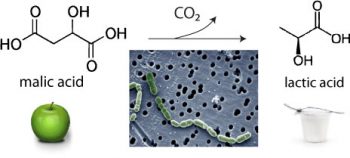I hope you’ve all had a chance to catch up on last week’s blog.
And yes, I do talk about a scientific equation (yawn)…
Sugar (grape juice) + yeast = alcohol + gas
…but I think you would agree that an equation with the word “alcohol” after the “equals” sign is a good thing, even if maths and science isn’t really your thing!!
As we know by now, that equation (better known as Primary fermentation) is the first step to making wine.
Some wines stop at that step (like a nice fresh Sauvignon Blanc). Others are allowed to progress through another process called Secondary fermentation. It comes with its own equation…
This particular type of secondary fermentation is called Malolactic fermentation (or MLF). While this bacterial fermentation occurs naturally for most red wines, it is also a handy tool in the production of some white wines.
And Rob is a huge fan!
Let’s find out why…
What is MLF?
Technically speaking, it is a process in which tart-tasting malic acid is converted to softer-tasting lactic acid (hence “malo”-“lactic”).
MLF often occurs naturally after the completion of primary fermentation. Or sometimes it can run concurrently with the primary fermentation.
It can also be induced by inoculation with a selected bacterial strain – Oenococcus oeni, a member of the lactic acid bacteria (LAB) family. This strain is chosen due to its ability to survive the harsh conditions of wine (high alcohol, low pH and low nutrients). It also produces some lovely flavours and aromas in the finished wine.
Why MLF?
MLF is super important when it comes to making (in particular) red wines. Malic acid in wine can be a carbon source for yeast and bacterial growth. And that can lead to spoilage, spritz, and unwanted flavours. Therefore it a process to microbiologically stabilise and protect the wine.
MLF can also be used to influence wine style. This is exactly what Rob likes to do with our Fumé Blanc, Chardonnay, and Rosé.
In addition to the important conversion of malic acid to softer lactic acid, MLF produces other chemical compounds which affect the aroma, flavour, and mouth-feel of the wine. Sensory terms such as ‘creamy’, ‘buttery’, ‘vanilla-like’, ‘nutty’, ‘spicy’, ‘fruity’, ‘vegetative’, ‘toasty’, ‘fuller’ and ‘rounded’ are used to describe MLF influences on wine.
You’ll definitely hear a few of these terms used when describing our Fumé, Chardy, and Rosé!
Speaking of which, here is a quick vintage 2021 fermentation update from Rob…
Sparkling Pinot Noir: Primary fermentation has finished and it has just started MLF. Very elegant and attractive aromas and flavour.
Sauvignon Blanc: completely dry (so fermentation has finished). It’s looking soft and wonderfully aromatic. This one doesn’t need MLF so the next step is preparation for bottling (not too much longer to wait for Sauvignon Blanc fans!!!).
Fumé Blanc: in barrel and now quite dry. Rob has inoculated it with the MLF bacteria, but the fermentation doesn’t seem to have started yet. Very lifted aromatic nose and a light already round palate.
Chardonnay: in barrel too, and has just finished fermentation. Looking exceptionally rich and flavoursome. No sign of MLF yet but won’t be long!!
Rosé: just finished primary fermentation and is yet to start MLF. Lovely strawberry/raspberry nose. Soft and interesting palate.
Light Dry Red (LDR): lovely perfumed nose and ultra-soft palate. It has just about completed MLF, so Rob can start thinking about early bottling preparation!
Pinot noir dry red: in barrel and starting to clarify nicely. Quite a rich full aroma and with a nice long palate. No sign that MLF has started yet.
Tempranillo Graciano: dark in colour and distinctively spicy/peppery on the nose. Firm but rich palate.
Shiraz: incredibly dark and with lovely ripe tannins and great flavours. Typical!! Well through MLF and in barrel, of course.
Exciting news for Sparkling Shiraz fans!!
 Our 2018 Sparkling Shiraz is just weeks away from release!
Our 2018 Sparkling Shiraz is just weeks away from release!
Hallelujah!!
We’ll all be able to breathe a huge sigh of relief when it’s safely back on our shelves and in your glass.
I am already gathering a list of sparkling red lovers eager to secure a bottle or two the second it arrives. Let me know if you’d like me to add your name.
Or, if you know how many bottles you’d like, send me an email and I’ll arrange for your order to be processed and sent (or available for collection) the day it turns up at the Cellar Bar! Easy!


Perhaps I should have paid more attention in school. I was wondering where the CO2 was coming from in your diagram (equation) for secondary fermentation. So I had to look up the formula for Malic acid C4H6O5. Now I know my curiosity is satisfied. However I had to watch a video on molecular structures to understand your diagram. If it is useful to anyone here is the video I watch.
https://www.khanacademy.org/science/biology/properties-of-carbon/carbon/v/representing-structures-of-organic-moleculesdon't understand why the malic acid diagram doesn’t show the carbon. Can anyone help?
Hi Robert, Thanks so much for your comment and further research. I love that I prompted a bit of self-education.
You did really well to get as far as you did in answering your question.
The reason why you’re not seeing any Cs (for carbon) in the formula is due to laziness! Scientists just know that a carbon atom is always at the intersections between the other atoms. So, at the pointy bits of that zigzaggy line is a carbon… one for each point… so C4.
Hope that makes sense!
Let me know if you have any other questions. I could talk about this stuff all day 🙂
Maree